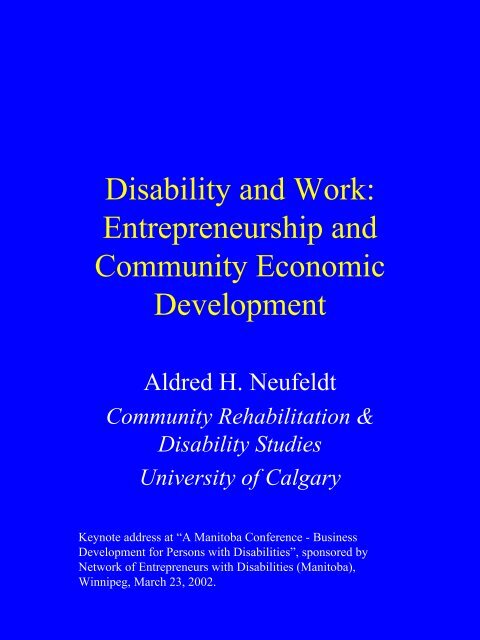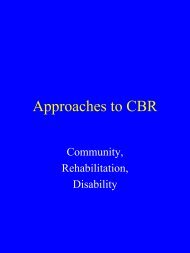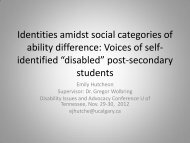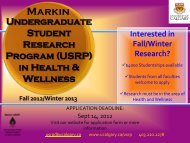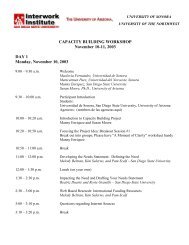Entrepreneurship and Community Economic Development
Entrepreneurship and Community Economic Development
Entrepreneurship and Community Economic Development
Create successful ePaper yourself
Turn your PDF publications into a flip-book with our unique Google optimized e-Paper software.
Disability <strong>and</strong> Work:<br />
<strong>Entrepreneurship</strong> <strong>and</strong><br />
<strong>Community</strong> <strong>Economic</strong><br />
<strong>Development</strong><br />
Aldred H. Neufeldt<br />
<strong>Community</strong> Rehabilitation &<br />
Disability Studies<br />
University of Calgary<br />
Keynote address at “A Manitoba Conference - Business<br />
<strong>Development</strong> for Persons with Disabilities”, sponsored by<br />
Network of Entrepreneurs with Disabilities (Manitoba),<br />
Winnipeg, March 23, 2002.
A few compelling statistics<br />
Data from Statistics Canada’s Health Activity Limitation Surveys in<br />
1986 <strong>and</strong> 1991. See Neufeldt & Mathieson (1995) <strong>and</strong> Neufeldt &<br />
Albright (1998).<br />
1986<br />
All working age<br />
Cdns<br />
• 78% in labour<br />
force<br />
• 8% unemployed<br />
Working age<br />
disabled Cdns<br />
• 48% in labour<br />
force<br />
• 7% unemployed<br />
Question: is this<br />
• systemic<br />
exclusion?<br />
1991<br />
All working age<br />
Cdns<br />
• 80% in labour<br />
force<br />
• 8% unemployed<br />
Working age<br />
disabled Cdns<br />
• 56% in labour<br />
force<br />
• 8% unemployed<br />
• untapped<br />
potential?
Purpose<br />
• Summarize the changing focus<br />
of how we think about disability<br />
<strong>and</strong> work<br />
• Give some examples of ‘Best<br />
Practice’<br />
• Consider what can be learned<br />
from these examples<br />
• Discuss possibilities
Changing Focus of how we<br />
think about Disability & Work<br />
• Fit in regular work - oldest<br />
expectation (new expression -<br />
Rotary’s current project)<br />
• Sheltered work - to support, to<br />
protect - developed in 17th century -<br />
<strong>and</strong> continues<br />
• Work place accessibility subsidies -<br />
mid-20th century<br />
• Supported employment - 1970s<br />
• Self-directed employment - 1990s
Self-directed Employment<br />
Where people with disabilities, to<br />
a significant degree, have a<br />
prime decision-making role in<br />
determining the kind of work<br />
that is done, how time is<br />
allocated, what types of<br />
investments in time <strong>and</strong> money<br />
are made, <strong>and</strong> how to allocate<br />
revenue generated<br />
From Neufeldt & Albright, 1998.
5 general approaches to<br />
self-directed employment<br />
• Self-employed (from consultant<br />
to kiosk to cocoa nut picking)<br />
• Small business<br />
• Worker owned <strong>and</strong> directed<br />
cooperative<br />
• Business subsidiary<br />
• <strong>Community</strong> economic<br />
development (cEd vs CeD)<br />
On <strong>Community</strong> <strong>Economic</strong> <strong>Development</strong>, <strong>and</strong> the different emphases, see<br />
references to Church <strong>and</strong> to Shragge
Some Models from around<br />
the World<br />
• Sole proprietor/personal<br />
corporation support - Bay St.<br />
George<br />
• Market creation - MicroLink<br />
• Social Enterprise - Berlin<br />
• Worker Cooperative - Churchill<br />
Park<br />
• <strong>Community</strong> <strong>Development</strong> -<br />
Morong<br />
• Alternative Trade Organizations<br />
Examples taken from Neufeldt & Albright (1998), <strong>and</strong> video Business as<br />
Usual
Barriers to Employment -<br />
in Canada <strong>and</strong> elsewhere<br />
Common<br />
• Education<br />
• Opportunity to gain workrelated<br />
skills<br />
• Accessibility<br />
• Transportation<br />
Specific to Self-directed Employ’t<br />
• Entrepreneurial skill<br />
• Management<br />
• Access to resources
Strategies commonly used<br />
• Advisory services (3)*<br />
• Education <strong>and</strong> training (2)*<br />
• Funding (1)*<br />
• Awareness raising about disability<br />
<strong>and</strong> work**<br />
• Marketing**<br />
• Equipment**<br />
• <strong>Community</strong> development**<br />
* Numbers 1 - 3 are the strategies most frequently<br />
used in our Study, the numbers indicating the rank<br />
order.<br />
** Successful self-directed employment creation<br />
programs used not only the ‘top 3’ strategies, but<br />
the others as well at the same time <strong>and</strong> consistently
Key Elements<br />
• Entrepreneurial attitude<br />
• Access to funding<br />
• Appropriate skills training<br />
• Business Approach - feasibility<br />
studies, marketing, information<br />
• Participation <strong>and</strong> control by<br />
people with disabilities<br />
• Appropriate ongoing support<br />
• Consultation services available<br />
• Package approach in strategy<br />
use
4 Cornerstones<br />
• Self-directed Identity - how we think of<br />
ourselves<br />
• The right ‘Know-how’<br />
– Literacy/numeracy<br />
–technical<br />
– business practices<br />
• Resourcing<br />
– Business advisory services<br />
– Financial & other capital support<br />
– Promoting personal savings<br />
– Marketing assistance<br />
• Enabling Environments<br />
– Rights based approach to employment<br />
– <strong>Economic</strong> opportunity<br />
We’ve not paid enough attention to the “self”
Thinking some more about<br />
CED<br />
Issues that push us out of current<br />
ways of thinking about work<br />
<strong>and</strong> disability:<br />
• the question of ‘self’ -<br />
confidence, experience,<br />
expectation<br />
• the question of opportunity -<br />
particularly in small<br />
communities<br />
• the question of social<br />
expectation
Guidelines for getting started<br />
• It doesn’t matter where one<br />
starts - so long as one starts<br />
• Attend to process<br />
• Learn by doing - when mistakes<br />
are made, learn from them<br />
• Develop disabled persons’<br />
participation & control<br />
• Nourish strong leadership<br />
• Create appropriate support or<br />
organizational structures -<br />
business for business, social<br />
support for social support
Getting started (cont’d)<br />
• Organize peer training <strong>and</strong><br />
support<br />
• Find effective partners<br />
(business, gov’t, community)<br />
• Find flexible <strong>and</strong> multiple<br />
funding sources - relying on<br />
single sources recipe for failure<br />
• Cultivate patience - one needs it<br />
• Form supportive networks -<br />
when failure occurs, as it will,<br />
we need support to go on
References<br />
1. Church, K. (1997) Because o where we’ve been: the business<br />
behind the business of psychiatric survivor economic<br />
development. Toronto: Ontario Council of Alternative<br />
Businesses.<br />
2. Neufeldt, A.H. & R. Mathieson (1995). Empirical dimensions of<br />
discrimination against disabled people. Health <strong>and</strong> Human<br />
Rights J., 1 (2), 174-189.<br />
3. Neufeldt, A.H. & A. Albright (1998). Disability <strong>and</strong> Self-directed<br />
employment: Business <strong>Development</strong> Models. North York:<br />
Captus Press; <strong>and</strong>, Ottawa: IDRC. (348pp)<br />
4. Neufeldt, A.H., Executive Producer; S. Kozak, Producer, A.<br />
Albright, Coordinator (1994): Business As Usual. Self-directed<br />
Employment by Disabled People. Calgary: Missing Link<br />
Productions, 34 min. video.<br />
NOTE: This video was awarded First Prize in the International Vision<br />
Category of films/videos at the International Congress, Rehabilitation<br />
International, Auckl<strong>and</strong>, N.Z., October, 1996.<br />
5. Shragge, E. (1997). <strong>Community</strong> economic development: in search of<br />
empowerment, 2nd ed. Montreal: Black Rose Books


